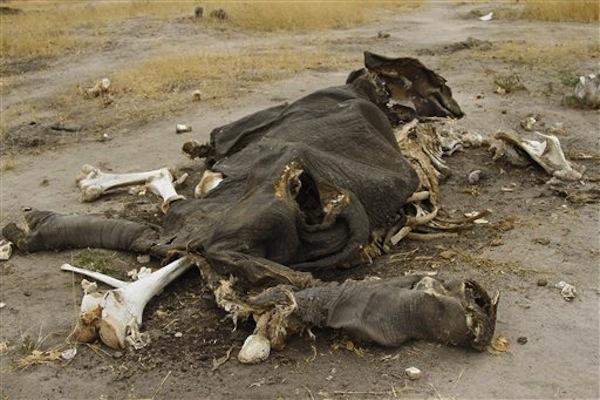
Elephant carcasses rot, the stench hanging on the air, in Hwange National Park, Zimbabwe, on September 29, 2013. Officials said that at least 91 animals had been poisoned with cyanide by poachers who hack off the tusks. Poachers poisoned the salt licks around the majestic beasts’ watering holes with cyanide, authorities said.
Source: Indian Country Today Media Network
The mineral-rich salt licks scattered around watering holes commonly draw elephants and other animals. But these familiar fixtures became death traps sometime in the past month for at least 91 elephants when poachers filled them with cyanide taken from illegal gold-mining operations.
The horrific tactic killed not only the majestic beasts but also lions, hyenas and vultures that fed on the remains or drank the water, authorities in Zimbabwe’s Hwange National Park, where the slaughter took place, told the Associated Press. The lethal chemical “attacks the bloodstream, kills almost instantly and causes rapid decomposition,” the AP noted.
Once the elephants were dead, their tusks were hacked off and smuggled out of the country.
“The magnitude of what we are witnessing today is much higher than what has occurred previously,” Zimbabwe’s environment minister, Saviour Kasukuwere told reporters as he toured the scene.
Authorities have arrested nine people suspected of poaching, the AP said, with three men sentenced to 16 years in prison.
The situation of elephants in Africa as a whole is dire, with poaching putting the species at risk for extinction. The Central African Republic is another site of unremitting elephant slaughter, The New York Times reported in a series a year ago.
RELATED: NYT Series Explores Epic Elephant Poaching That Threatens Species’ Survival
At least 35,000 elephants were killed in Africa during 2012 alone, according to the Wildlife Conservation Society. That’s 96 per day.
Last December the United Nations flagged illegal wildlife trafficking, including that of elephant and other endangered animal parts, as a dire problem—and an illegal global trade worth copy9 billion per year.
RELATED: Trafficking of Wildlife Marks Fourth Largest Illegal Global Trade, Worth copy9 Billion Annually
National Geographic detailed the slaughter and how it is fueled by the Chinese ivory market in an October 2012 series, Blood Ivory. And in 2011 Vanity Fair gave a haunting portrayal of elephant slaughter by the poverty-stricken Maasai, who once revered them, in Agony and Ivory.
Those poachers commonly shoot from helicopters with high-powered assault rifles. But the poison method has caused an environmental crisis as well as hurt elephant populations, the AP said. Zimbabwe’s Environmental Management Authority will burn the cyanide-laced carcasses and will have to remove the toxin from the areas where it has been spread. The salt licks must be dug out, the AP said, and the top layers of soil removed—everything that has been contaminated with cyanide granules.
Moreover, two deep wells that supply the watering holes may also be poisoned and need to be sealed, the AP reported, and new wells are needed. This will be hard because the agency is underfunded and understaffed in Zimbabwe’s struggling economy.
Nevertheless, Kasukuwere said the country would stand firm against poaching.
“We will cooperate with international organizations such as Interpol to crack down on the pay masters,” he told reporters. “So the war is on, it’s a war which we will win, we are not going to surrender.”
Read more at http://indiancountrytodaymedianetwork.com//2013/10/02/deadly-combo-91-elephants-slaughtered-poachers-using-cyanide-illegal-gold-mines-151544
